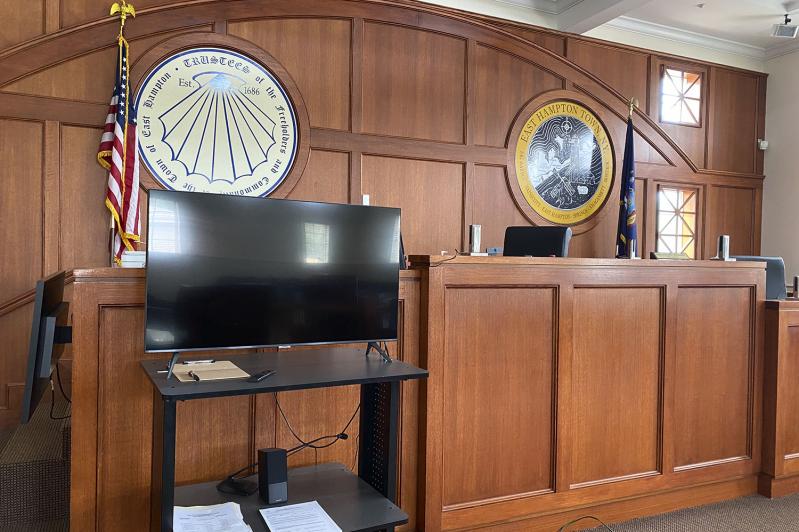Five years ago, a defendant set to appear in Sag Harbor Village Justice Court might have been transported in handcuffs from a jail in Riverhead or Yaphank to appear in court for a minute or two, before being taken back to jail in a police cruiser, still handcuffed — a two-hour-plus round-trip ride.
This requires two officers and a sheriff’s car, along with jail staff, which places a burden on both the judicial system and the law enforcement agencies.
Now, however, virtual hearings — a change introduced during the pandemic — have stuck around, altering court proceedings and increasing the efficiency of local courthouses. When nothing majorly substantive is on the docket, remote video alleviates the travel hustle.
Virtual hearings began not long after Covid hit, with village and town courts following blueprints from larger jurisdictions.
“It was the pandemic that really changed things,” said Sag Harbor Village Justice Carl Irace. “And I think there was a lot of opportunity for technology to step in and make things better.”
Typically, remote video proceedings occur for weekend arraignments, when wrangling all the parties into one room is a logistical problem. For these Zoom hearings, attorneys — and defendants, when necessary — appear on a screen in the corner of the Sag Harbor courtroom, above a metal detector at the entrance.
“Remote video proceedings are permitted with the client’s consent,” Justice Irace said. “That’s the wisdom that’s been handed down to me as a practitioner and as a judge. So, every time we do it, I always make sure I ask attorneys if they’re authorized by their clients to proceed by remote video.”
While Justice Irace spoke largely on how remote proceedings have offered innovation in the judicial process, East Hampton Town Justice David Filer looked back into the long history of public court proceedings.
Historically, an idea stretching through the English common law system to ancient times maintains that criminal court is a public forum, Justice Filer said.
When the pandemic hit, a question arose: “How does the public get on there if it’s a virtual conference? Is that public enough, right, given this history?”
In East Hampton Town Justice Court, remote proceedings have been retained for some matters, including certain arraignments, procedural hearings, and traffic violations. Justice Filer reserves his Thursday calendar for remote proceedings.
“With these virtual cases that I have on Thursday, they’re going to be criminal cases that are somewhere in the process of negotiation where the defense lawyer is negotiating with the prosecutor’s office,” Justice Filer said. Essentially, the parties are working toward a pretrial resolution.
A small number of cases go to trial, he added, and “the rest of them come to some outcome they think is best in that situation.”
The law in New York State has allowed remote proceedings since before the pandemic, Justice Filer said, so the sudden switch over four years ago “didn’t require any twists and turns of the law.”
Typically, after being arrested, people charged with a criminal offense are held in custody overnight to await arraignment the next morning, where they usually enter a not-guilty plea and a judge sets bail, if there is any.
“If we can get somebody on a remote video link at 8:30 a.m., this person’s going to be released at 8:45 or 8:50,” Justice Irace said of remote arraignments.
Alternatively, the court could wait for interpreters, stenographers, and attorneys to appear in person. “Now [the defendant]’s getting out at 11:30 or 12, and that’s an injustice,” the Sag Harbor judge said.
“I think the greater injustice is keeping somebody in custody longer than they need to,” Justice Irace added. “The reality is that most people are charged with offenses that are eligible for release, or at least have an argument for release.”
In East Hampton Town Justice Court, remote video proceedings were kept in situations where it increased the efficiency of the judicial process, Justice Filer said. Nonetheless, he added, “I think some courts probably abandoned it as soon as they could.”
Post-arraignment remote video proceedings are rare in Sag Harbor, and Justice Irace requests that defendants appear in person for certain proceeding a guilty plea, a request for bail change, a request for modification of a protective order, or a ruling on a motion. As for rulings, Justice Irace believes that defendants should be present in person to discuss the meaning of the decisions with their attorneys.
For criminal arraignments in East Hampton, the village tends to prefer remote hearings, while the town leans toward in-person hearings, Justice Filer said.
“In the Supreme Court and in federal court, [remote video]’s great,” said Alex Kriegsman, an attorney based in Sag Harbor who handles predominantly civil litigation.
In local justice courts, though, Zoom can be a bit more of a “mixed bag,” he said. “They used to pay us to drive to court and sit around. You’d get a bill for two, three hours for something that actually took 10 or 15 minutes.”
“A lot of these court appearances are ministerial in nature,” Mr. Kriegsman added, “and it’s so expensive and inefficient to have to pay a lawyer to go into court and wait around for the judge.” With remote video, the wait time for lawyers is greatly reduced.
“People coming and going is a more acute issue in our court,” said Justice Irace. Space is tighter in his courtroom than in others on the South Fork, he said.
There are around 66 seats, and on some days there may be as many as 80 defendants lined up. In Sag Harbor, Zoom goes a long way toward court congestion.
Justice Irace, who has been on the bench for about a year and a half, does have some concerns about what he called “the truly public side of court proceedings,” echoing Justice Filer’s comments.
To preserve the integrity of the video links, the court provides them only to attorneys. Members of the public are free to view the proceedings but must do so from the courtroom. Justice Irace described this as “the reduced obviousness of the public’s opportunity to spectate.”
Another downside of Zoom, according to Mr. Kriegsman, concerns “more substantive procedures.” Such matters are more easily discussed in a private setting, he said, and should be conducted in person.
“It’s harder to have a candid conversation when you’re on a live Zoom with the judge and other attorneys,” he said.
“I think the goal of the public court sessions is for people to come and answer the allegations and resolve matters,” Justice Irace said. “Making it easier to do so — that’s a goal of mine.”
—
Correction: An earlier version of this article incorrectly stated that certain post-arraignment court procedures — motion hearings, bond reviews, protective order modifications, and guilty plea hearings — are held virtually in Sag Harbor Village Justice Court. These hearings are examples of those typically held in-person, Justice Carl Irace said.


